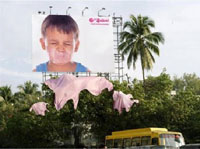
Top stories

Marketing & MediaTunisian journalist Chatha Belhaj Mubarak freed after sentence cut
Tarek Amara 15 hours





More news







ESG & Sustainability
The Helpers: Good Things Guy launches SA’s first user-driven charity directory











I normally keep my opinion pieces light and entertaining… quality points concealed in an entertaining wrapping. With the global economy in the state it's in, however, jokes seem a little inappropriate. So here are some serious comments and opinions more suitable for the times.
Every country seems to be quaking at the knees in the face of economic failure and shrinking consumer spending. In South Africa we have our own problems like a 30% drop of the rand against the US$, which will have a massive impact on the majority of our retail prices. In addition, we are facing an uncertain political future. Before you cut your wrists, take the pills, dust off the passport, load the gun, book a therapy session, however - remember South Africans have faced far greater challenges in the past and have not been found wanting.
Huge economic and social problems are relatively new to the US and Europe. They have had it easy over the last 10 to 15 years and became lazy and complacent - unlike South Africa, where business has always been difficult in a volatile environment. We have always had to work harder and cleverer. That's why the best South Africans are always in such demand overseas.
In my opinion it's going to be tough. But it's always been tough here. Sure, the usual wave of people will leave and companies will fail; it's always been like that. South Africans are better equipped to deal with these mammoth challenges than most, however, and we will work harder to generate success - as we always have.
To succeed we have to work smarter and wrench value out of every marketing rand we spend to get a return on our marketing investment. The only way to increase market share in a static or receding marketplace is to take business from our competitors. To do that more effectively we need to recognise the massive changes in the way we need to communicate to people. We have to move away from the classic intrusive advertising strategy that has been the backbone of communication since its inception, towards the engagement strategy.
“The most fundamental evolution in today's communications landscape is the shift from short-term campaigns to long-term structural initiatives. The advertising industry has always thought in terms of short-term spikes rather than ongoing dialogue. Whenever a product is to be launched, or awareness has to be increased, or a competitor is on the up, there is a brief surge in communication efforts, after which there is often a return to radio silence. Anyone would admit this is a strange way of building relationships. A good solid relationship does not rely on brief appearances, but on ongoing conversation and interaction. And new tools and techniques allow brands to have that ongoing, permanent bond”. Ref. Tom Himpe - Brand Strategist.
We know this is sound advice, but we also know most advertisers cannot fund continuous television or print advertising over the long period. So to achieve long-term structural communications we need to think differently to how we have been thinking over the last 30 years. And if we are to compete and succeed in the new “negative” economic environment we had better learn how to do this quickly.
Let's look globally at an example of how Warner Bros has tackled the engagement problem. Traditional media, such as television and print, were the core of the new Superman movie marketing campaign. The campaign was then taken to another level with the addition of “elevator advertising” that really engages and affects people. This campaign generated a viral marketing event that was contagious and encouraged people to talk about the communication and spread the message. Can you think of anything your company has produced as a window display or poster or POS to create a viral campaign that has had this type of effect?

Let's stop thinking about individual segments in our segmented marketing structure and re-focus on every element within our communication mix as a tool to use in our long-term structural communications strategy. Advertising, package design, licensing, window displays (the new media in this age of impulse purchase), sales promotion, merchandising, point-of-sale material, account stuffers, PR - everything! They are all vital in creating the all important exciting conversation and interaction that will give us our permanent bond with our customers. And they must speak consistently in the tone with which you want the customer to perceive you.

Up until now, market segmentation and target groups have been our mantra, the key to successful branding, as we have come to understand it - and rightly so. We get the research into the field, identify one person who symbolises our target market and create relevant communication directed at them alone. Classic marketing 101. In my opinion this classic marketing strategy based on years of thinking and experience will be tested during hard times as manufacturers and retailers compete to increase market share in stagnated markets.
This will continue to work better in Europe and the US where there is little difference in the culture of the mass population, but in tough times in South Africa with our complex demographics and cultural values and needs, we cannot afford to miss out on sales to any segment of our market. We need all the business we can get from as many different target groups as possible. It's not as simple as it used to be and those marketers who are able to change their strategies and tactics to suit the new difficult marketplace will prosper. Those unable to do so will struggle.
Price or value will become even more of an issue as the rand weakens and customers chase value. The temptation to commoditise will be greater. But there must be a long-term strategy in place for when the economy improves and there is a need to maintain brand differentiation for both retailers and manufacturers. It's a delicate balance between offering value through lowest price and giving away your brand values.
Over a year ago, a manufacturer asked us to make recommendations on one of their product brands. It was to be a different take, but advertising focused. In preparation I walked two major malls searching all major retailers for their product and could not find one. As a result, we produced a strategy that was based on firstly selling their product in to retailers to achieve the distribution they did not have - the sell-in, and supporting the sell-in with ads in the retailers' own magazines to drive sales - the sell-out… and to use the offer of the advertising spend as an incentive. We did not get the business.
A year later this last Christmas, I walked the same product-crowded malls again searching for their brand. Again I could not find one product. Sometimes we need to bring sales and advertising together to achieve results. If you see a huge gap between sales and marketing, this could be a great place to start when considering building your new aggressive strategy.
We need to keep fighting - as we always have. But we are up to it - as we have always been.